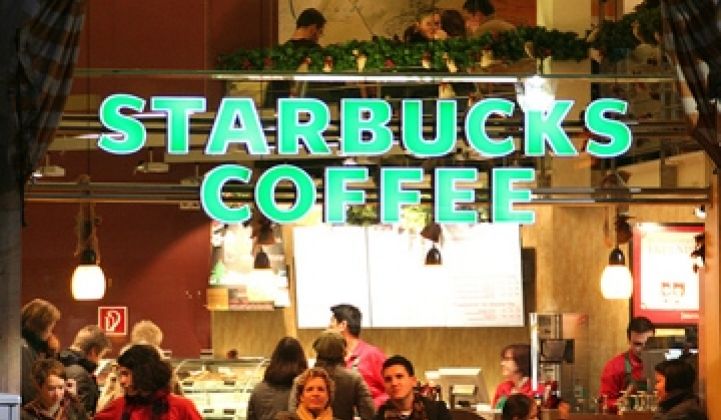Coffee behemoth Starbucks will replace conventional lights with light emitting diode (LED) bulbs in 8,000 stores by March of next year.
The switch from incandescents and other vacuum-and-chemical lights to solid state lighting is expected to reduce energy consumption in a store by 7 percent. Starbucks overall has a goal of reducing energy consumption by 25 percent by the end of next year. (Suggestion from an occasional consumer: Turn down the temperature on the tea.) The company also said it will incorporate LEED concepts into pilot stores.
The LED lights come from General Electric, which tweaked one of its existing designs to meet the aesthetic and design criteria of Starbucks. You just don't get that Starbucks mood lighting out of a box. 1,000 outlets in the U.S. have already been retrofitted with LEDs.
Lighting is undergoing a massive change. On Dec. 31, the hugely popular and highly inefficient Edison incandescent lamp turns 130 years old. The next day it's 2010, and Australia will move to phase them out. The EU, the U.S. and other nations will follow over the next few years.
LED manufacturers are expected to be some of the major beneficiaries of the swap. LEDs consume about one-tenth of the power of an incandescent and half of the power of fluorescents. The bulbs also last 50,000 hours, giving them a 19 to 20-year effective lifespan.
While the bulbs still cost far more than conventional bulbs, the price is coming down. Panasonic, Sharp and Lemnis Lighting all have 60-watt equivalents that cost around $40. The commercial market will likely adopt LEDs first – the lower maintenance and replacement costs lead to a quicker payback. Consumers generally don't hire people to change their bulbs so the economic argument is tougher. Still, LED-makers like GE and Osram are experimenting with ways to these enhance lights – Osram has one coming for consumers that can splash muted colors into a room – to boost the shelf appeal.
Potentially, LEDs can also cut air conditioning bills because the light itself doesn't generate heat.
Commercial outlets will also likely begin to adopt networking to light fixtures to dim LEDs and fluorescents during the day to save power.
Photo via Flickr/Creative Commons.



